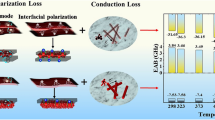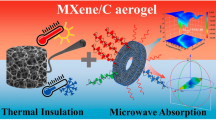Abstract
Optically transparent and thermally conductive polymer composites are required for next-generation opto-electronic devices. The present work aimed at creating polymer composite films with enough optical transparency and superior normal-to-plane thermal conductivity. We successfully prepared composite films with transmittances more than 80% (at a wavelength of 600 nm) and thermal conductivity more than 0.7 Wm−1 K−1. For the polymeric matrix, we employed a highly refractive polyimide. α-alumina particles distributed in the polyimide matrix enhanced the normal-to-plane thermal conductivity of the composite films significantly. Similar refractive indices of the matrix polyimide and α-alumina particles suppressed light scattering in the polymer composites. The clever choice of the constituent materials conquered a trade-off between optical transparency and thermal conductivity in polymer composites.





Similar content being viewed by others
References
Ngo I, Jeon S, Byon C (2016) Thermal conductivity of transparent and flexible polymers containing fillers: a literature review. Int J Heat Mass Tran 98:219–226. https://doi.org/10.1016/j.ijheatmasstransfer.2016.02.082
Mark JE (2007) Physical properties of polymers handbook, 2nd edn. Springer, New York
Zhou L, Yang Z, Luo W, Han X, Jang S, Dai J, Yang B, Hu L (2016) Thermally conductive, electrical insulating, optically transparent bi-layer nanopaper. ACS Appl Mater Interfaces 8:28838–28843. https://doi.org/10.1021/acsami.6b09471
Uetani K, Okada T, Oyama HT (2016) Thermally conductive and optically transparent flexible films with surface-exposed nanocellulose skeletons. J Mater Chem C 4:9697–9703. https://doi.org/10.1039/C6TC03318K
Zheng H, Lei X, Cheng T, Liu S, Zeng X, Sun R (2017) Enhancing the thermal dissipation of a light-converting composite for quantum dot-based white light-emitting diodes through electrospinning nanofibers. Nanotechnology 28:265204. https://doi.org/10.1088/1361-6528/aa72d6
Wu X, Gao Y, Yao H, Sun K, Fan R, Li X, An Y, Lei Y, Zhang Y (2020) Flexible and transparent polymer/cellulose nanocrystal nanocomposites with high thermal conductivity for thermal management application. J Appl Polym Sci 137:48864. https://doi.org/10.1002/app.48864
Hu Z, Wang S, Liu Y, Qu Z, Tan Z, Wu K, Shi J, Liang L, Lu M (2020) Constructing a layer-by-layer architecture to prepare a transparent, strong, and thermally conductive boron nitride nanosheet/cellulose nanofiber multilayer film. Ind Eng Chem Res 59:4437–4446. https://doi.org/10.1021/acs.iecr.9b05602
Wu K, Liu D, Lei C, Xue S, Fu Q (2020) Is filler orientation always good for thermal management performance: a visualized study from experimental results to simulative analysis. Chem Eng J 394:124929. https://doi.org/10.1016/j.cej.2020.124929
Sato K, Tominaga Y, Hotta Y, Imai Y (2022) A facile method to prepare layered solid fillers-based polymer composites with isotropic thermal conductivity. Compos Part A-Appl Sci Manuf 154:106776. https://doi.org/10.1016/j.compositesa.2021.106776
Poostforush M, Azizi H (2014) Superior thermal conductivity of transparent polymer nanocomposites with a crystallized alumina membrane. Express Polym Lett 8:293–299
Loste J, Lopez-Cuesta JM, Billon L, Garay H, Save M (2019) Transparent polymer nanocomposites: an overview on their synthesis and advanced properties. Prog Polym Sci 89:133–158. https://doi.org/10.1016/j.progpolymsci.2018.10.003
Imai Y, Terahara A, Hakuta Y, Matsui K, Hayashi H, Ueno N (2009) Transparent poly(bisphenol A carbonate)-based nanocomposites with high refractive index nanoparticles. Eur Polym J 45:630–638. https://doi.org/10.1016/j.eurpolymj.2008.12.031
Ruan K, Shi X, Guo Y, Gu J (2020) Interfacial thermal resistance in thermally conductive polymer composites: a review. Compos Commun 22:100518. https://doi.org/10.1016/j.coco.2020.100518
Althues H, Henle J, Kaskel S (2007) Functional inorganic nanofillers for transparent polymers. Chem Soc Rev 36:1454–1465. https://doi.org/10.1039/B608177K
Shilpa KN, Nithin KS, Sachhidananda S, Madhukar BS (2017) Visibly transparent PVA/sodium doped dysprosia (Na2Dy2O4) nano composite films, with high refractive index: an optical study. J Alloy Compd 694:884–891. https://doi.org/10.1016/j.jallcom.2016.10.004
Lin H, Day DE, Stoffer JO (1992) Optical and mechanical properties of optically transparent poly(methyl methacrylate) composites. Polym Eng Sci 32:344–350. https://doi.org/10.1002/pen.760320507
Tan MC, Patil SD, Riman RE (2010) Transparent infrared-emitting CeF3:Yb-Er polymer nanocomposites for optical applications. ACS Appl Mater Interfaces 2:1884–1891. https://doi.org/10.1021/am100228j
Zhang K, Xiao GD, Zeng Z, Wan C, Li J, Xin S, He X, Deng S, Zhang Y, Cui C, He Y, Liu L, Ku CS, Yuen MMF (2019) A novel thermally conductive transparent die attach adhesive for high performance LEDs. Mater Lett 235:216–219. https://doi.org/10.1016/j.matlet.2018.09.170
Liu J, Nakamura Y, Terraza CA, Shibasaki Y, Ando S, Ueda M (2008) Highly refractive polyimides derived from 2,8-bis(p-aminophenylenesulfanyl) dibenzothiophene and aromatic dianhydrides. Macromol Chem Phys 209:195–203. https://doi.org/10.1002/macp.200700305
You N, Suzuki Y, Yorifuji D, Ando S, Ueda M (2008) Synthesis of high refractive index polyimides derived from 1,6-bis(p-aminophenylsulfanyl)-3,4,8,9-tetrahydro-2,5,7,10-tetrathiaanthracene and aromatic dianhydrides. Macromolecules 41:6361–6366. https://doi.org/10.1021/ma800982x
You N, Fukuzaki N, Suzuki Y, Nakamura Y, Higashihara T, Ando S, Ueda M (2009) Synthesis of high-refractive index polyimide containing selenophene unit. J Polym Sci Pol Chem 47:4428–4434. https://doi.org/10.1002/pola.23497
Tapaswi PK, Choi M, Jeong K, Ando S, Ha C (2015) Transparent aromatic polyimides derived from thiophenyl-substituted benzidines with high refractive index and small birefringence. Macromolecules 48:3462–3474. https://doi.org/10.1021/acs.macromol.5b00432
Kim H, Ku B, Goh M, Ko H, Ando S, You N (2019) Synergistic effect of sulfur and chalcogen atoms on the enhanced refractive indices of polyimides in the visible and near-infrared regions. Macromolecules 52:827–834. https://doi.org/10.1021/acs.macromol.8b02139
Weber MJ (2003) Handbook of optical materials. CRC Press, Florida
Gao BZ, Xua JZ, Pengc JJ, Kang FY, Dua HD, Lia J, Chiang SW, Xu CJ, Hu N, Ning XS (2015) Experimental and theoretical studies of effective thermal conductivity of composites made of silicone rubber and Al2O3 particles. Thermochim Acta 614:1–8. https://doi.org/10.1016/j.tca.2015.06.005
Sato K, Ijuin A, Hotta Y (2015) Thermal conductivity enhancement of alumina/polyamide composites via interfacial modification. Ceram Int 41:10314–10318. https://doi.org/10.1016/j.ceramint.2015.04.088
Saito K, Sato K, Tominaga Y, Imai Y (2022) Computational prediction of microstructures in α-alumina/PMMA composites and its experimental verification. Polym Compos 43:339–346. https://doi.org/10.1002/pc.26378
Fisher TS (2014) Thermal energy at the nanoscale. World Scientific, Singapore
Ni H, Liu J, Wang Z, Yang S (2015) A review on colorless and optically transparent polyimide films: chemistry, process and engineering applications. J Ind Eng Chem 28:16–27. https://doi.org/10.1016/j.jiec.2015.03.013
Barnes HA, Hutton JF, Walters K (1989) An Introduction to Rheology. Elsevier, Amsterdam
Sato K, Yilmaz H, Ijuin A, Hotta Y, Watari K (2012) Acetic acid mediated interactions between alumina surfaces. Appl Surf Sci 258:4011–4015. https://doi.org/10.1016/j.apsusc.2011.12.091
Xie S, Zhu B, Li J, Wei X, Xu Z (2004) Preparation and properties of polyimide/aluminum nitride composites. Polym Test 23:797–801. https://doi.org/10.1016/j.polymertesting.2004.03.005
Sato K, Horibe H, Shirai T, Hotta Y, Nakano H, Nagai H, Mitsuishi K, Watari K (2010) Thermally conductive composite films of hexagonal boron nitride and polyimide with affinity-enhanced interfaces. J Mater Chem 20:2749–2752. https://doi.org/10.1039/B924997D
Tanimoto M, Yamagata T, Miyata K, Ando S (2013) Anisotropic thermal diffusivity of hexagonal boron nitride-filled polyimide films: effects of filler particle size, aggregation, orientation, and polymer chain rigidity. ACS Appl Mater Interfaces 5:4374–4382. https://doi.org/10.1021/am400615z
Xiao T, Fan X, Fan D, Li Q (2017) High thermal conductivity and low absorptivity/emissivity properties of transparent fluorinated polyimide films. Polym Bull 74:4561–4575. https://doi.org/10.1007/s00289-017-1974-6
Guo Y, Zhou Y, Xu Y (2021) Engineering polymers with metal-like thermal conductivity-Present status and future perspectives. Polymer 233:124168. https://doi.org/10.1016/j.polymer.2021.124168
Sigmund WM, Bell NS, Bergström L (2000) Novel powder-processing methods for advanced ceramics. J Am Ceram Soc 83:1557–1574. https://doi.org/10.1111/j.1151-2916.2000.tb01432.x
Lewis JA (2000) Colloidal processing of ceramics. J Am Ceram Soc 83:2341–2359. https://doi.org/10.1111/j.1151-2916.2000.tb01560.x
Sato K, Yilmaz H, Hotta Y, Ijuin A, Watari K (2009) Dispersion of ceramic particles in aqueous media with surface-grafted dispersant. J Am Ceram Soc 92:256–259. https://doi.org/10.1111/j.1551-2916.2008.02838.x
Acknowledgements
This work is based on results obtained from a project, JPNP16010, commissioned by the New Energy and Industrial Technology Development Organization of Japan (NEDO).
Author information
Authors and Affiliations
Corresponding authors
Ethics declarations
Conflict of interest
The authors declare that they have no known competing financial interests or personal relationships that could have appeared to influence the work reported in this paper.
Additional information
Publisher's Note
Springer Nature remains neutral with regard to jurisdictional claims in published maps and institutional affiliations.
Supplementary Information
Below is the link to the electronic supplementary material.
Rights and permissions
Springer Nature or its licensor holds exclusive rights to this article under a publishing agreement with the author(s) or other rightsholder(s); author self-archiving of the accepted manuscript version of this article is solely governed by the terms of such publishing agreement and applicable law.
About this article
Cite this article
Sato, K., Tominaga, Y. & Imai, Y. Optically transparent and thermally conductive composite films of α-alumina and highly refractive polyimide. Polym. Bull. 80, 9479–9488 (2023). https://doi.org/10.1007/s00289-022-04528-0
Received:
Revised:
Accepted:
Published:
Issue Date:
DOI: https://doi.org/10.1007/s00289-022-04528-0




